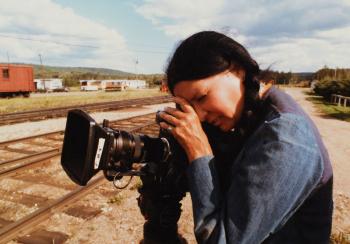Image Caption
Summary
Local Journalism Initiative Reporter
Windspeaker.com
The Children Have to Hear Another Story is an exhibit opening in the Art Museum at the University of Toronto on Sept. 7. It highlights decades of work by First Nations filmmaker Alanis Obomsawin.
Born in 1932, the Abenaki American-Canadian is well known for writing and directing documentaries about issues facing Indigenous communities across Canada. Her films speak to the hardships faced by Indigenous people, the racism, the bullying, the struggles for rights and recognition, displacement and state-mandated assimilation.
“I think it’s just a very important exhibition to give insight into what has been accomplished and how much important work has been done by her and has affected so many others ever since and has given courage to others,” said Barbara Fischer, director of the Art Museum.
In total Obomsawin has directed 57 films, had a singing career and created many pieces of artwork, which are incorporated into the display.
“It means a lot of details and a lot of organizing to do this, and it’s very touching to think that they would have that kind of interest,” said Obomsawin.
Celebrating her life's work, the exhibit presents Obomsawin’s work by decade, showcasing not only her documentaries but also the archives related to each production, including artwork, prints, music and media coverage.
The exhibit started in Germany last year, said 91-year-old Obomsawin. “It was the director of the museum at that time who decided to do an exhibition for me when I was in Berlin.”
Once she agreed to participate, members of the Haus der Kulturen der Welt Berlin Museum visited Obomsawin’s home in Montreal to go through her personal archives.
“They looked at a lot of my archives, but when I went to Berlin and I saw the actual exhibition, it’s like it’s 50 years of my work. Can you imagine that?” she said.
Beginning in 1960, the display shows a young Obomsawin featured in newspapers for her singing, but many of the articles were somewhat of a surprise to her.
“At first you came to the first room. It says 1960, and then they had a lot of interviews I had done then at that time … and me being, not attacked but almost by reporters…I was shocked.”
Traveling through each decade visitors will see the passion she had to educate people about the mistreatment of Indigenous populations.
“It was very different than you know, and I really revolted against the educational system because I got beat up very badly as a child in school here, and mainly because of what they were teaching. When I figured that one out, then I thought the children have to hear another story,” Obomsawin explained.
“I started very early because at first my big battle was education. I was very upset from the ways that they were teaching the history of this country. It started like that because I suffered a lot at that time. I was very young, and it was very difficult and so I figured out a way to produce changes and I’ve succeeded.”
She said Indigenous people were depicted as savages with no morals or religion. That their language was that of Satan.
“You know, stuff like that, and you get to the point where you start believing this,” she said. “So, I revolted. Like, I was very, you know, I became pretty wild.”
She started singing, telling traditional stories and talking about the history of her people to students in schools. “Hundreds and hundreds,” she said, and even some residential schools.
Transitioning to film was something she felt was important in order to “have our people telling their own story.”
“There were quite a few films that had been made and it was mostly a big British voice from someplace else who would tell about you, and I found that very upsetting,” Obomsawin said.
Once her interest piqued in filmmaking, she joined the National Film Board and has been working there ever since.
“That’s how I was able to make a lot of material, a lot of films for telling the history and with different communities and make sure that people were present in the classroom, their voice and themselves. That’s what I fought for this whole time, and I’m still doing it.”
Available on the National Film Board website are many of the films Obomsawin has produced and are featured in the exhibition.
Fischer described Obomsawin’s work as inspiring and is looking forward to the exhibition which highlights someone who has shown so many people the truths about Indigenous stories.
“She made films, documentary films from a (different) perspective. The Oka Crisis for instance. She was behind the barricades together with them, those who fought against the territorial takeover of their ancestral lands,” said Fischer.
“So that’s a perspective you just know you would not get in the mainstream media and so she’s made, kind of created really, room for others to see how another point of view can really make a difference in the perception of the broader public. And I think that kind of activism has worked on many fronts. She’s stood up for the rights of Indigenous children. She’s stood up for those whose voices were not heard.”
For more information on the exhibit please visit The Children Have to Hear Another Story – Art Museum at the University of Toronto (utoronto.ca)
Local Journalism Initiative Reporters are supported by a financial contribution made by the Government of Canada.

